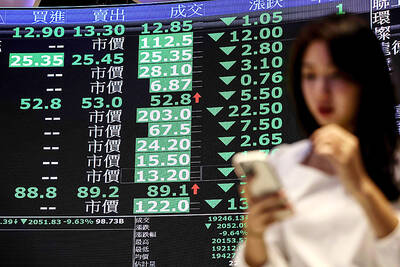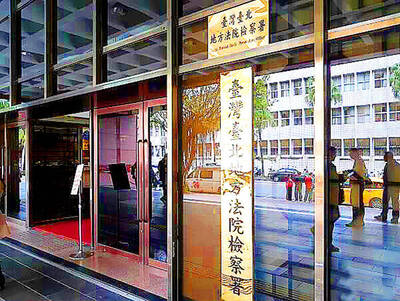The Republic of China navy has made a major breakthrough in the development of an absorbent paint that can provide stealth capabilities to its weapons platforms, local media reported yesterday.
The radar-absorbing material, which reports said has been in development for a number of years, was recently tested on a 57-tonne Hai Ou (“Seagull”)-class fast attack boat, which has no stealth features, the Chinese-language United Daily News reported.
Two Seagulls, the No. 53 and No. 59, were deployed during the test. The No. 53, whose hull, machine guns, missiles and cabin were coated with the absorbent material, remained invisible to radar, while the No. 59, which was used as a control and did not receive the coating, was easily detected.
Only after the No. 53 came within sight did the radar finally detect it, reports said.
The stealth coating has resulted in a halving of the distance at which a vessel remains invisible to radar, reports said.
The test with the two Seagulls reportedly involved both land-based radar and radar on board a ship at sea that was approached by the two attack boats. When the two Seagulls closed in on the ship, the control vessel was picked up by radar from a distance of 10km, while the No. 53, with the coating, was only detected after it had come within viewing distance.
When the two boats sailed away from the ship and could barely be observed by the naked eye, the No. 53 was no longer picked up by radar, while the control was still clearly visible, even at a distance exceeding 10km.
Unconfirmed reports within the navy also claim that during a test at night, an observer vessel was unable to pick up the No. 53 by radar at a distance of 730m.
Although Navy Command confirmed it had tested the coating on the Seagulls, it would not comment further on the tests.
It is not known whether the stealth coating would be used in the navy’s fleet of locally manufactured 170-tonne Kuang Hua VI (“Glorious China”)-class missile boats, whose design and shape already give it stealth capabilities.
Ten Kuang Hua-class vessels entered service in May last year. Another 20 are to be delivered by China Shipbuilding Corp, Taiwan (台灣國際造船) to the navy by next February, bringing the fleet to 30.
The Kuang Hua VI, which come armed with four Hsiung Feng II (“Brave Wind”) ship-to-ship missiles developed by the Chungshan Institute of Science and Technology (CSIST, 中山科學研究院), is intended to replace about 30 of the Israeli-designed Seagulls after the almost 20-year-old vessels are retired at the end of this year.
ADDITIONAL REPORTING BY AFP

Intelligence agents have recorded 510,000 instances of “controversial information” being spread online by the Chinese Communist Party (CCP) so far this year, the National Security Bureau (NSB) said in a report yesterday, as it warned of artificial intelligence (AI) being employed to generate destabilizing misinformation. The bureau submitted a written report to the Legislative Yuan in preparation for National Security Bureau Director-General Tsai Ming-yen’s (蔡明彥) appearance before the Foreign Affairs and National Defense Committee today. The CCP has been using cognitive warfare to divide Taiwanese society by commenting on controversial issues such as Taiwan Semiconductor Manufacturing Co’s (TSMC, 台積電) investments in the

HELPING HAND: The steering committee of the National Stabilization Fund is expected to hold a meeting to discuss how and when to utilize the fund to help buffer the sell-off The TAIEX plunged 2,065.87 points, or 9.7 percent, to close at 19,232.35 yesterday, the highest single-day percentage loss on record, as investors braced for US President Donald Trump’s tariffs after an extended holiday weekend. Amid the pessimistic atmosphere, 945 listed companies led by large-cap stocks — including Taiwan Semiconductor Manufacturing Co (TSMC, 台積電), Hon Hai Precision Industry Co (鴻海精密) and Largan Precision Co (大立光) — fell by the daily maximum of 10 percent at the close, Taiwan Stock Exchange data showed. The number of listed companies ending limit-down set a new record, the exchange said. The TAIEX plunged by daily maxiumu in just

‘COMPREHENSIVE PLAN’: Lin Chia-lung said that the government was ready to talk about a variety of issues, including investment in and purchases from the US The National Stabilization Fund (NSF) yesterday announced that it would step in to staunch stock market losses for the ninth time in the nation’s history. An NSF board meeting, originally scheduled for Monday next week, was moved to yesterday after stocks plummeted in the wake of US President Donald Trump’s announcement of 32 percent tariffs on Taiwan on Wednesday last week. Board members voted to support the stock market with the NT$500 billion (US$15.15 billion) fund, with injections of funds to begin as soon as today. The NSF in 2000 injected NT$120 billion to stabilize stocks, the most ever. The lowest amount it

INVESTIGATION: The case is the latest instance of a DPP figure being implicated in an espionage network accused of allegedly leaking information to Chinese intelligence Democratic Progressive Party (DPP) member Ho Jen-chieh (何仁傑) was detained and held incommunicado yesterday on suspicion of spying for China during his tenure as assistant to then-minister of foreign affairs Joseph Wu (吳釗燮). The Taipei District Prosecutors’ Office said Ho was implicated during its investigation into alleged spying activities by former Presidential Office consultant Wu Shang-yu (吳尚雨). Prosecutors said there is reason to believe Ho breached the National Security Act (國家安全法) by leaking classified Ministry of Foreign Affairs information to Chinese intelligence. Following interrogation, prosecutors petitioned the Taipei District Court to detain Ho, citing concerns over potential collusion or tampering of evidence. The